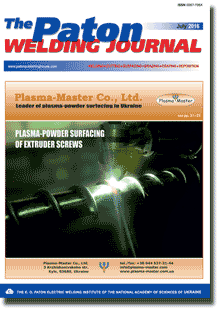| 2016 №07 (02) |
DOI of Article 10.15407/tpwj2016.07.03 |
2016 №07 (04) |

The Paton Welding Journal, 2016, #7, 17-20 pages
Possibilities of reduction of growth of intermetallic interlayer in steel brazed using brazing filler metals of copper-phosphorus system
A.N. Pisarev, V.F. Khorunov, S.V. Maksymova And V.N. Tovmachenko
E.O. Paton Electric Welding Institute, NASU 11 Kazimir Malevich Str., 03680, Kiev, Ukraine. E-mail: office@paton.kiev.ua
Abstract
Brazed joints are widely used in development of structures in the different branches of industry. Their service properties depend on safety of the brazed joints. One of the reasons of low properties of the brazed structures is formation of the solid continuous interlayers of brittle intermetallic compounds along seam–brazed metal interface. This work studies some dependencies of formation of iron phosphides in steel brazing using Cu–P filler metals. Using the reference data and thermodynamic calculations it was an attempt to reduce their growth and rate of formation by means of manganese, titanium and nickel alloying. Interaction of metal being brazed with brazing filler metal can provoke two mutually antithetic processes at the interface, namely dissolving the solid metal in the liquid, and diffusion of atoms of the liquid metal in the solid one with formation of chemical compounds. Investigation of phase and chemical composition of interaction zone showed that it consists of a Cu-based solid solution and Fe2P and FeP phosphides, forming at the interface in form of continuous interlayer. Thermodynamic possibility of phosphide formation is verified by calculation of Gibbs thermodynamic potential of corresponding reactions. Study of phase equilibriums and mutual solubility of components and compounds of Fe2P–Cu3P–Ni section of tetradic system Fe–Ni–Cu–P showed that nickel and its phosphides can form the continuous solid solutions with iron as well as copper. Similarity of the crystal lattices of copper solution and iron phosphide and their parameters indicate that introduction of nickel to Cu–P brazing filler metal will provide their solving in a brazed seam. 11 Ref., 3 Figures.
Keywords: brazing, Cu–P brazing filler metal, intermetallics’ solubility, thermodynamic calculations, diffusion, phosphides, X-ray pattern, phase
Received: 02.02.16
Published: 02.08.16
References
- Mars, O., Srtoizcek, M., Persson, U. (2012) Erosion control of stainless steel brazing alloys. In: of 5th Int. Brazing and Soldering Conf. (Las Vegas, USA, April 22–25, 2012), 169–173.
- Lashko, N.F., Lashko, S.V. (1977) Contact and metallurgical processes in brazing. Moscow: Metallurgiya.
- Duffey, M.J., Marchal, J.T., Loney, M.R. et al. (2015) Strength of brazed joints and metallurgical testing of Cu–4Sn–6P and Cu–40Zn–1Sn–0,3Si silver-free filler metals. In: of Int. Brazing and Soldering Conf. (Long Beach, USA, April 19–22, 2015).
- Li Yajiang, Wang Juan, Liu Kun et al. (2015) Microstructure and fracture morphology of Mo/CuCr18-Ni18 brazing joint with Ni–Cr–P filler metal. In: Ibid.
- Nikitin, V.I. (1967) Physical-chemical phenomena under the impact of liquid metals on hard metals. Moscow: Atomizdat.
- Dybkov, V.I. (2002) Solid phase chemical kinetics and reactive diffusion. Kiev: NANU.
- Shatinsky, V.F., Zbozhnaya, O.M. (1976) Producing diffusion coatings in fusible metals medium. Kiev: Naukova Dumka.
- (1986) Constitutional diagrams of binary and multicomponent systems on iron base: Refer. Book. Ed. by O.A. Bannykh. Moscow: Metallurgiya.
- Chase, M.W. (1980) JANAF Thermochemical Tables. 3rd ed., 1856. Midland: Thermal Group.
- Matyushenko, N.N. (1969) Crystalline structures of binary compounds: Refer. Book. Moscow: Metallurgiya.
- Kornilov, I.I. (1964) Metallides and their interaction. Moscow: Nauka.
